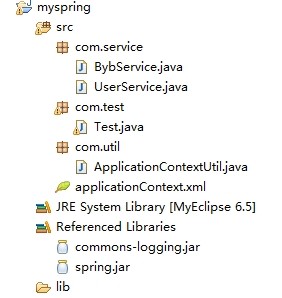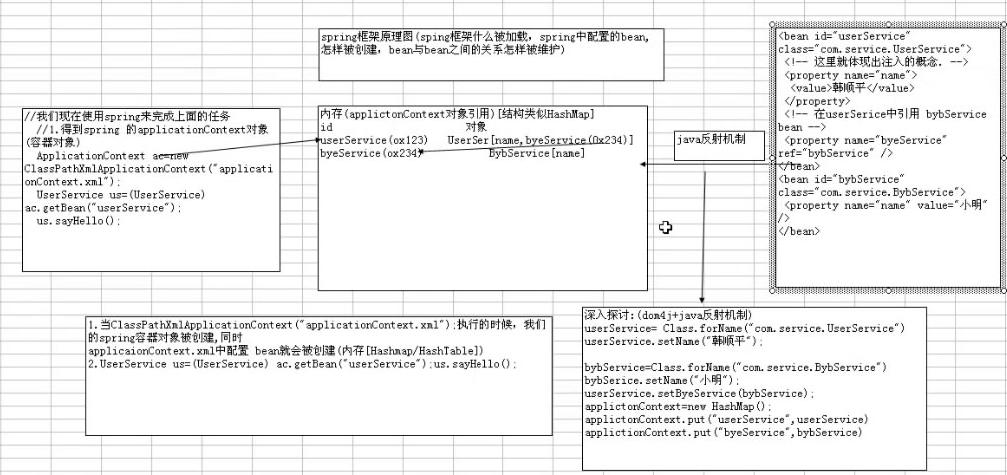Spring入门案例
一、sping中的概念
spring是一个容器框架,可以配置各种bean(action/service/domain/dao),并且可以维护bean与bean的关系,当我们需要使用某个bean的时候,通过getBean(id)使用即可。
bean:是java中的任何一种对象,javabean/service/action/数据源/dao
bean元素的作用是,当我们的spring框架加载的时候,spring就会自动的创建一个bean对象,并放入内存
ioc(inverse of control)控制反转:
所谓控制反转就是把创建对象(bean),和维护对象(bean)的关系的权利从程序中转移到spring的容器(applicationContext.xml),儿程序本身不再维护。
di(dependency injection)依赖注入:
实际上di和ioc是同一个概念,spring设计者认为di更准确的表示spring的核心技术。
二、开发一个spring项目
1、引入spring的开发包
最小配置spring.jar该包把常用的jar都包括,还要写日志的包common-logging.jar
2、创建spring的一个核心文件applicationContext.xml
[hibernate有核心hibernate.cfg.xml,struts有核心文件struts-config.xml],该文件一般放在src目录下,在该文件中引入xsd文件,可以从给出的案例中拷贝一份。
3、配置applicationContext.xml,配置bean

applicationContext.xml
<?xml version="1.0" encoding="UTF-8"?> <!-- - Application context definition for JPetStore's business layer. - Contains bean references to the transaction manager and to the DAOs in - dataAccessContext-local/jta.xml (see web.xml's "contextConfigLocation"). --> <beans xmlns="http://www.springframework.org/schema/beans" xmlns:xsi="http://www.w3.org/2001/XMLSchema-instance" xmlns:aop="http://www.springframework.org/schema/aop" xmlns:tx="http://www.springframework.org/schema/tx" xsi:schemaLocation=" http://www.springframework.org/schema/beans http://www.springframework.org/schema/beans/spring-beans-2.5.xsd http://www.springframework.org/schema/aop http://www.springframework.org/schema/aop/spring-aop-2.5.xsd http://www.springframework.org/schema/tx http://www.springframework.org/schema/tx/spring-tx-2.5.xsd"> <!-- 在容器文件中配置bean(service/dao/domain/action/数据源) --> <!-- bean元素的作用是,当我们的spring框架加载的时候,spring就会自动的创建一个bean对象,并放入内存 UserService userService = new UserService(); userService.setName("韩顺平"); --> <bean id="userService" class="com.service.UserService"> <!-- 这里体现出注入的概念 --> <property name="name"> <value>韩顺平</value> </property> <!-- 在userService中引用bybService bean --> <property name="bybService" ref="bybService"/> </bean> <bean id="bybService" class="com.service.BybService"> <property name="name" value="小明"/> </bean> </beans>
4、开发代码
UserService.java
package com.service; public class UserService { private String name; private BybService bybService; public String getName() { return name; } public void setName(String name) { this.name = name; } public void sayHello(){ System.out.println("hello "+name); bybService.sayBye(); } public BybService getBybService() { return bybService; } public void setBybService(BybService bybService) { this.bybService = bybService; } }
BybService.java
package com.service; public class BybService { private String name; public String getName() { return name; } public void setName(String name) { this.name = name; } public void sayBye(){ System.out.println("bye "+name); } }
ApplicationContextUtil.java
package com.util; import org.springframework.context.ApplicationContext; import org.springframework.context.support.ClassPathXmlApplicationContext; final public class ApplicationContextUtil { private static ApplicationContext ac = null; private ApplicationContextUtil(){}; static{ ac = new ClassPathXmlApplicationContext("applicationContext.xml"); } public static ApplicationContext getApplicationContext(){ return ac; } }
Test.java
package com.test; import org.springframework.context.ApplicationContext; import org.springframework.context.support.ClassPathXmlApplicationContext; import com.service.BybService; import com.service.UserService; import com.util.ApplicationContextUtil; public class Test { public static void main(String[] args) { /* //使用传统的方法,来调用UserService的sayHello方法 UserService userService = new UserService(); userService.setName("顺平"); userService.sayHello(); //print: hello 顺平 */ //使用spring来完成上面的任务 //1、得到spring的applicationContext对象(容器对象) ApplicationContext ac = new ClassPathXmlApplicationContext("applicationContext.xml"); UserService us = (UserService) ac.getBean("userService"); us.sayHello(); //print: hello 顺平\r\nbye 小明 //使用ApplicationContextUtil //((UserService) ApplicationContextUtil.getApplicationContext().getBean("userService")).sayHello(); //从ac[代表applicationContext容器]中 BybService bybService = (BybService) ac.getBean("bybService"); bybService.sayBye(); //print: bye 小明 } }
三、细节讨论
传统的方法和使用spring的方法
1、使用spring,没有new对象,我们把创建对象的任务交给spring框架
2、spring的运行原理图

分类:
JAVA





【推荐】编程新体验,更懂你的AI,立即体验豆包MarsCode编程助手
【推荐】凌霞软件回馈社区,博客园 & 1Panel & Halo 联合会员上线
【推荐】抖音旗下AI助手豆包,你的智能百科全书,全免费不限次数
【推荐】轻量又高性能的 SSH 工具 IShell:AI 加持,快人一步
· 深入理解 Mybatis 分库分表执行原理
· 如何打造一个高并发系统?
· .NET Core GC压缩(compact_phase)底层原理浅谈
· 现代计算机视觉入门之:什么是图片特征编码
· .NET 9 new features-C#13新的锁类型和语义
· Spring AI + Ollama 实现 deepseek-r1 的API服务和调用
· 《HelloGitHub》第 106 期
· 数据库服务器 SQL Server 版本升级公告
· 深入理解Mybatis分库分表执行原理
· 使用 Dify + LLM 构建精确任务处理应用